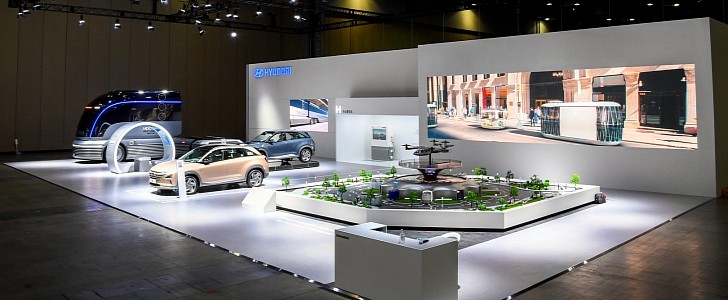This year has been plagued with the disappearance of almost all major events in the automotive industry’s regular calendar. But, courtesy of Hyundai, we found one small – specialized – gem: this first edition of the ‘H2 Mobility + Energy Show’ is taking place in South Korea until July 3rd.
And it is a real steel and actual strobe lights event, not the virtual kind – making us realize we have been dearly missing the pleasure of strolling among the latest auto models. Of course, if you are not in South Korea these days it is still a virtual jump to the booth prepared by Hyundai.
The company is among the remaining few still putting faith in hydrogen fuel cell technology and they are highlighting virtually everything they have at H2. The HDC-6 Neptune Concept (a decidedly retro-futuristic Class 8 hydrogen-powered heavy-duty truck) is making its home-market debut.
And the company has revealed its intention to put it into series production in three to four years, complete with an upgraded fuel cell system. The Neptune premiered late last year at the North American Commercial Vehicle Show in Atlanta. And its main source of inspiration is simple: America’s classic streamliner trains from the 1930s.
The Nexo FCEV SUV is also present, along with a complete mockup of the automaker’s future ‘smart mobility ecosystem’. The latter will be made from elements residing both on the soil and in the air – the upcoming UAMs (Urban Air Mobility unit) and PBVs (Purpose Built Vehicle) that will be shared by passengers in transit through the company’s ‘Hubs’.
Hyundai is also looking to expand its business opportunities into commercial hydrogen mobility solutions, displaying at the Korean event a mobile fuel cell generator with a maximum output of 160 kW. The unit was constructed by piecing together two stacks from the Nexo and could be used to charge a couple of EVs at the same time or even electric buses and trucks.
The company is among the remaining few still putting faith in hydrogen fuel cell technology and they are highlighting virtually everything they have at H2. The HDC-6 Neptune Concept (a decidedly retro-futuristic Class 8 hydrogen-powered heavy-duty truck) is making its home-market debut.
And the company has revealed its intention to put it into series production in three to four years, complete with an upgraded fuel cell system. The Neptune premiered late last year at the North American Commercial Vehicle Show in Atlanta. And its main source of inspiration is simple: America’s classic streamliner trains from the 1930s.
The Nexo FCEV SUV is also present, along with a complete mockup of the automaker’s future ‘smart mobility ecosystem’. The latter will be made from elements residing both on the soil and in the air – the upcoming UAMs (Urban Air Mobility unit) and PBVs (Purpose Built Vehicle) that will be shared by passengers in transit through the company’s ‘Hubs’.
Hyundai is also looking to expand its business opportunities into commercial hydrogen mobility solutions, displaying at the Korean event a mobile fuel cell generator with a maximum output of 160 kW. The unit was constructed by piecing together two stacks from the Nexo and could be used to charge a couple of EVs at the same time or even electric buses and trucks.









